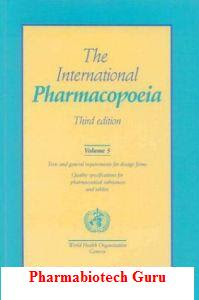21st June 2011
Tuesday 07:59 AM
International Pharmacopoeia
Tuesday 07:59 AM
Hello readers, hope you all doing well in your professional field. This post gives you a brief review of International Pharmacopoeia published by WHO. As we all know that international pharmacopoeia plays an important role in the pharmaceutical industry for registrations and regulations of drug products or substances. So it is a very important book of industrial pharmacists particularly.
Download Link: http://ebookee.org/go/?u=http://turbobit.net/4j4op6x76hlk.html International Pharmacopoeia
The International Pharmacopoeia 1 (Ph. Int.) comprises a collection of recommended procedures for analysis and specifications for the determination of pharmaceutical substances (active ingredients and excipients) and dosage forms that is intended to serve as source material for reference or adaptation by any WHO Member State wishing to establish pharmaceutical requirements. The pharmacopoeia, or any part of it, shall have legal status, whenever a national or regional authority expressly introduces it into appropriate legislation.
History: The history of The International Pharmacopoeia dates back to 1874 when the need to standardize terminology and to specify dosages and composition of drugs led to attempts to produce an international pharmacopoeial compendium. The first conference, called by the Belgian Government and held in Brussels in 1902, resulted in the Agreement for the Unification of the Formulae of Potent Drugs, which was ratified in 1906 by 19 countries. The outcome considerably influenced the subsequent publication of national pharmacopoeias.
First edition:
The Third World Health Assembly, held in May 1950, formally approved the publication of the Pharmacopoea Internationalis and recommended, in accordance with Article 23 of the WHO Constitution, “the eventual inclusion of its provisions by the authorities responsible for the pharmacopoeias”. It was thus recommended that the Pharmacopoea Internationalis was not intended to be a legal pharmacopoeia in any country unless adopted by the pharmacopoeial authority of that country. From that moment the World Health Organization constituted the Permanent International Pharmacopoeia Secretariat. The first edition, published with the aim of creating a worldwide, unified pharmacopoeia, relied on collaboration with national pharmacopoeia commissions for its preparation. It was published in two volumes (1951 and 1955) and a supplement (1959) in English, French and Spanish, and was also translated into German and Japanese. Altogether, it included 344 monographs on drug substances, 183 monographs on dosage forms (capsules, injections, tablets and tinctures) and 84 tests, methods, and general requirements.
A large number of national pharmacopoeias and official lists were examined and assistance was also obtained from the International Pharmaceutical Federation (FIP) to determine the selection of substances and products to be described in the pharmacopoeia. Latin was chosen for the monograph titles because of its distinction as an international language. Experts collaborated with the WHO Expert Committee on Biological Standardization with regard to biological products, and with those working in specific divisions, e.g. malaria, maternal and child health, mental health, and venereal diseases, to help collate the required information.
Second edition:
The second edition was published in 1967 as Specifications for the Quality Control of Pharmaceutical Preparations, with a subtitle classifying it as the second edition of The International Pharmacopoeia. Owing to the development of new analytical techniques such as infrared spectroscopy, chromatography (column, paper and thin-layer), non-aqueous titration, and radioactivity, the second edition incorporated numerous alterations and constituted a revision of the first edition. The selection of monographs and appendices was based largely on the availability, at the time of preparation, of specifications intended for publication in national pharmacopoeias and in other volumes of specifications for pharmaceutical quality control. Specifications for 162 pharmaceutical preparations not included in the first edition were introduced in the second edition, while 114 monographs were deleted, based on feedback from the first edition. New analytical methods were also added. The specifications and methods in the monographs were tested in a number of national pharmacopoeial and pharmaceutical quality control laboratories, in pharmaceutical manufacturers’ laboratories, and at various pharmacopoeial institutes.
Third Edition:
Since 1979, the drugs appearing in The International Pharmacopoeia have been selected from the list of essential drugs based on the first report of the WHO Expert Committee on the Selection of Essential Drugs. Specifications are provided in the monographs for the identification, purity, and content of the essential drugs appearing in the WHO Model List of Essential Drugs, and their updates.
The third edition eventually consisted of five volumes: Volume 1 contained general methods of analysis; Volumes 2 and 3, quality specifications for the majority of essential drug substances in the WHO Model List of Essential Drugs and Volume 4, information on tests, methods, and general requirements and quality specifications for pharmaceutical substances, excipients, and dosage forms. Volume 5, the final volume, contained tests and general requirements for dosage forms and quality specifications for pharmaceutical substances and tablets, which practically completed the list of monographs for active pharmaceutical substances, and a section on antimalarial drug substances and their most widely used dosage forms.












No comments:
Post a Comment